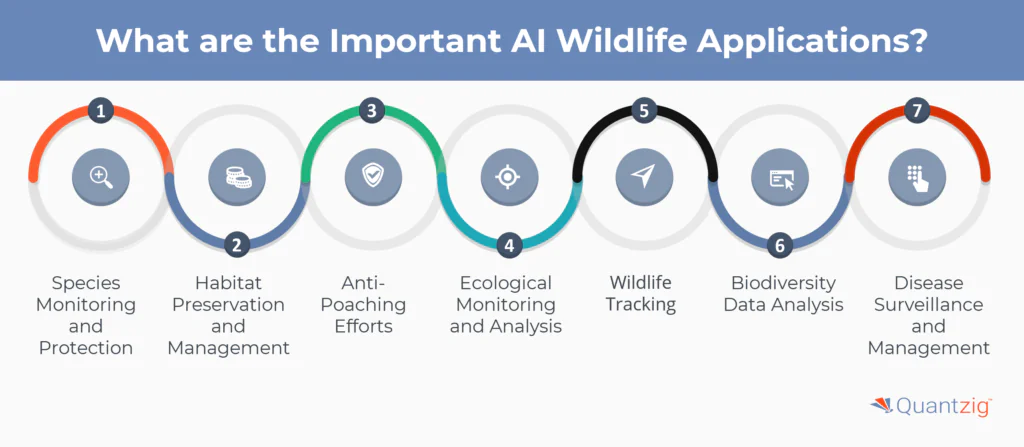The intersection of technology and environmental stewardship has given rise to a new era in wildlife conservation, marked by unprecedented advancements. Traditional wildlife monitoring techniques often struggle to keep pace with escalating challenges such as habitat loss, climate change, and dwindling food supplies. However, AI-driven analysis offers a beacon of hope, unveiling the transformative power of AI in wildlife conservation.
The cutting-edge use of conservation AI has sparked a revolutionary change in how we protect our natural world. At the forefront of this revolution is Artificial Intelligence (AI). Quantzig’s insightful analysis explores how AI is not only supporting but actively enhancing efforts to monitor endangered species, manage habitats, and combat poaching. This article dives deep into the multifaceted ways AI in wildlife conservation is transforming the field, underscoring its significance as a vital tool in environmental stewardship.
Book a demo to experience the meaningful insights we derive from data through our ai analytics tools and platform capabilities. Schedule a demo today!
Request a Free DemoTable of Contents
What is AI in Wildlife?

AI in Wildlife refers to the application of artificial intelligence (AI) technologies in wildlife conservation and management. It leverages advanced computing techniques, such as machine learning, computer vision, and data analytics, to gather, analyze, and interpret vast amounts of data related to wildlife behavior, habitat monitoring, species identification, and more. The goal is to enhance conservation efforts by automating tasks and generating actionable insights. From tracking endangered species to detecting poaching and forecasting ecological trends, conservation AI tools are revolutionizing biodiversity preservation.
Key Applications of AI in Wildlife Conservation

In the realm of conservation, the intersection of technology and wildlife preservation has paved the way for crucial advancements. As we grapple with challenges like habitat loss, climate change impact, and dwindling food supplies for herbivores, traditional wildlife monitoring techniques alone prove insufficient. However, the integration of AI-driven analysis offers a promising solution across application of wildlife AI, key areas include:
From employing thermal sensors to detect animal presence in their natural habitats, to analyzing animal vocalizations for disease monitoring, AI has revolutionized how we track wildlife movement patterns and predict ecological trends. Antipoaching measures have been bolstered through automated monitoring, while genetic analysis aids in understanding biodiversity and ecological insights. Join us as we explore the vital role of AI in wildlife conservation and its myriad applications in safeguarding our planet’s most precious inhabitants.
1. AI’s Application in Species Monitoring and Protection
AI’s role in species monitoring and protection has become increasingly indispensable. Sophisticated algorithms capable of complex image and pattern recognition are now deployed by conservationists to track animal movements, monitor population dynamics, and pinpoint individual animals with astonishing precision. This is particularly valuable for the study of elusive or threatened species, where conventional tracking methods fall short. Through wildlife AI, critical data for the formulation of protection strategies are collected with a level of efficiency and accuracy that was previously unattainable. In recent years, conservation AI has emerged as a potent tool, revolutionizing traditional approaches and providing unprecedented insights into the intricate ecosystems that house diverse flora and fauna.
2. AI in Habitat Preservation and Management
By analyzing large-scale environmental data, AI can detect changes in ecosystems and predict potential threats. These insights help guide the preservation of habitats like forests and wetlands. AI doesn’t just assist with analysis—it enables conservation teams to act more swiftly and effectively in maintaining ecological balance.
3. Technology’s Role in Anti-Poaching Efforts
In the fight against poaching, AI in wildlife conservation has emerged as a game-changer. Vast conservation areas can now be monitored using AI-assisted drones and advanced surveillance systems that function 24/7. These systems efficiently identify suspicious activities and trigger real-time alerts, facilitating rapid response by anti-poaching teams. This innovation has significantly enhanced wildlife crime prevention efforts.
4. Ecological Monitoring and Analysis
Artificial Intelligence-driven technologies now enable ecological monitoring with previously unattainable scale and precision. From satellite imagery to camera traps, machine learning algorithms process data in real time, offering actionable insights into population assessments, habitat health, and emerging threats. These insights empower conservationists to implement timely, data-backed strategies.
5. Wildlife Tracking and Predictive Analytics
AI plays a pivotal role in tracking and protecting endangered species using sophisticated GPS tracking, sensor devices, and predictive analytics. Machine learning models analyze vast datasets to forecast animal movements and recognize potential threats. These predictions allow conservationists and anti-poaching teams to act proactively, improving species survival rates.
6. Biodiversity Data Analysis
The immense volume of biodiversity data can overwhelm manual analysis methods. AI excels in processing such datasets, revealing patterns and extracting meaningful insights. These capabilities help researchers enhance habitat management, optimize species preservation tactics, and prioritize conservation investments more strategically.
7. Disease Surveillance and Management
AI technologies are essential for wildlife disease surveillance. Machine learning detects anomalies in animal behavior and environmental data that might indicate early-stage disease outbreaks. Early detection supports timely interventions, mitigating spread and minimizing ecosystem disruption.
Challenges and Limitations of AI in Wildlife Conservation

While AI in wildlife conservation holds immense promise, several challenges must be addressed to maximize its effectiveness. Below is a tabular breakdown of key limitations:
| Challenge | Description |
| Data Quality & Availability | High-quality, labeled datasets are necessary for effective AI models. However, acquiring such data in remote or under-resourced regions can be difficult. |
| Algorithmic Bias | If AI models are trained on incomplete or skewed data, they may generate biased results, leading to flawed conservation decisions. |
| Resource Constraints | Implementing AI systems often demands significant computational power and specialized expertise—both of which may be scarce for conservation groups. |
| Collaboration & Data Sharing | Effective conservation AI requires robust data-sharing frameworks and collaboration across organizations, which can be hindered by infrastructure and policy gaps. |
By confronting these limitations head-on, stakeholders can unlock the full potential of AI in wildlife conservation to protect global biodiversity.
Quantzig’s Technical Perspective
Quantzig’s approach to integrating AI in wildlife conservation is rooted in a deep understanding of the technology’s potential coupled with a commitment to ethical and responsible application. We are invested in developing artificial intelligence in wildlife conservation that not only embody technical excellence but are also in harmony with conservation ethics. Our solutions are designed to empower conservationists with actionable insights, streamline operations, and ensure a sustainable future for wildlife populations.
Experience the advantages firsthand by testing a customized complimentary pilot designed to address your specific requirements. Pilot studies are non-committal in nature.
Request a free pilotUse Cases of AI in Wildlife

Artificial Intelligence has emerged as a revolutionary force in wildlife conservation, providing innovative solutions to address complex challenges. Here, we delve into several high-impact use cases where AI is making substantial contributions to the preservation of biodiversity.
1. Remote Sensing and Habitat Monitoring:
AI facilitates remote sensing and habitat monitoring by processing vast amounts of satellite imagery and sensor data. Machine learning algorithms analyze changes in vegetation, land cover, and animal movements, enabling conservationists to monitor ecosystems in near real-time. This data-driven approach enhances our understanding of habitat dynamics, aiding in the identification of potential threats and the development of targeted conservation strategies.
2. Automated Species Identification:
Traditional methods of species identification can be time-consuming and prone to errors. AI algorithms, powered by computer vision and deep learning, offer a solution by automating the identification of species through image and audio analysis. This not only expedites the identification process but also enables researchers to amass comprehensive datasets for population monitoring, essential for effective conservation planning.
3. Predictive Analytics for Anti-Poaching Measures:
AI-driven predictive analytics have become instrumental in anti-poaching efforts. By analyzing historical poaching data, environmental factors, and wildlife movement patterns, machine learning models can predict potential poaching hotspots. This foresight allows conservationists and law enforcement to allocate resources strategically, implementing preemptive measures to deter poachers and protect vulnerable species.
4. Behavioral Analysis and Conservation Management:
These technologies contribute to wildlife conservation by analyzing animal behavior patterns. By processing data from sensors, camera traps, and acoustic monitoring devices, machine learning models can discern behavioral nuances, aiding in the formulation of effective conservation management strategies. This includes understanding migration patterns, mating behaviors, and habitat preferences, essential for promoting the well-being of wildlife populations.
5. Disease Surveillance and Early Detection:
This tool plays a pivotal role in disease surveillance within wildlife populations. Machine learning algorithms analyze diverse datasets, including animal behavior, environmental conditions, and health indicators, to detect early signs of disease outbreaks. This early detection allows conservationists to implement rapid response measures, mitigating the spread of diseases and safeguarding the overall health of ecosystems.
Get started with your complimentary trial today and delve into our platform without any obligations. Explore our wide range of customized, consumption driven analytical solutions services built across the analytical maturity levels.
Start your free trialUtilizing AI systems, including ML algorithms and object detection models, allows for the automation of wildlife monitoring and tracking processes, drawing data from diverse sources such as satellite imagery, drones, and Acoustic Sensors for Wildlife Monitoring. Machine Learning algorithms aid in animal classification through shape and size analysis in drone imagery, while also identifying species based on their vocalizations captured by acoustic sensors. Object detection algorithms play a pivotal role in recognizing animals within drone images, with the aid of thermal sensors for detecting heat signatures. Such AI-driven analysis supports conservation efforts, including endangered species protection and habitat monitoring, thus contributing to the preservation of the planet’s natural beauty and biodiversity.
Conclusion:
AI’s burgeoning role in wildlife conservation offers a beacon of hope amid the increasing threats to global biodiversity. Leveraging traditional wildlife monitoring techniques alongside antipoaching measures and genetic analysis, AI-driven analysis provides invaluable insights into ecological trends and disease monitoring. By automating wildlife monitoring and utilizing thermal sensors for tracking wildlife movement patterns, AI contributes to preserving natural habitats and safeguarding herbivores’ food supply. Additionally, AI plays a vital role in predicting climate change impact and enhancing our understanding of animal vocalizations. The evolution of AI in wildlife conservation not only demonstrates human ingenuity but also underscores its pivotal role in conservation efforts. As we continue to harness AI’s capabilities, it promises to become an indispensable tool in mitigating environmental challenges and ensuring the preservation of our planet’s biodiversity.



